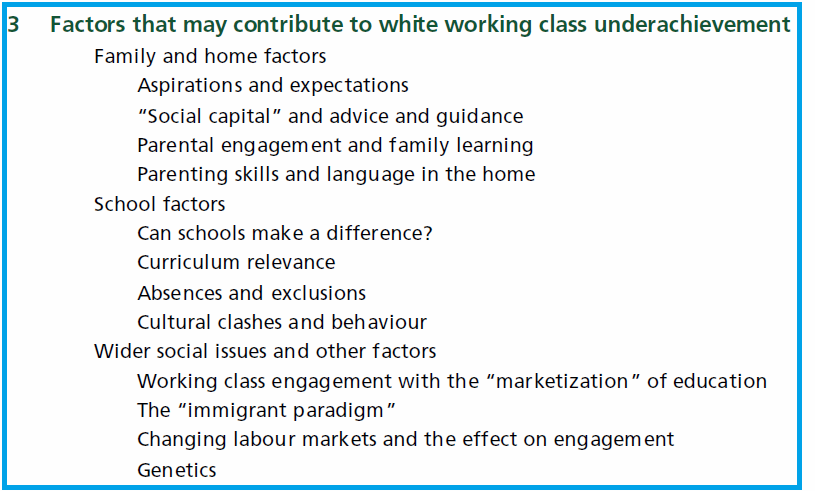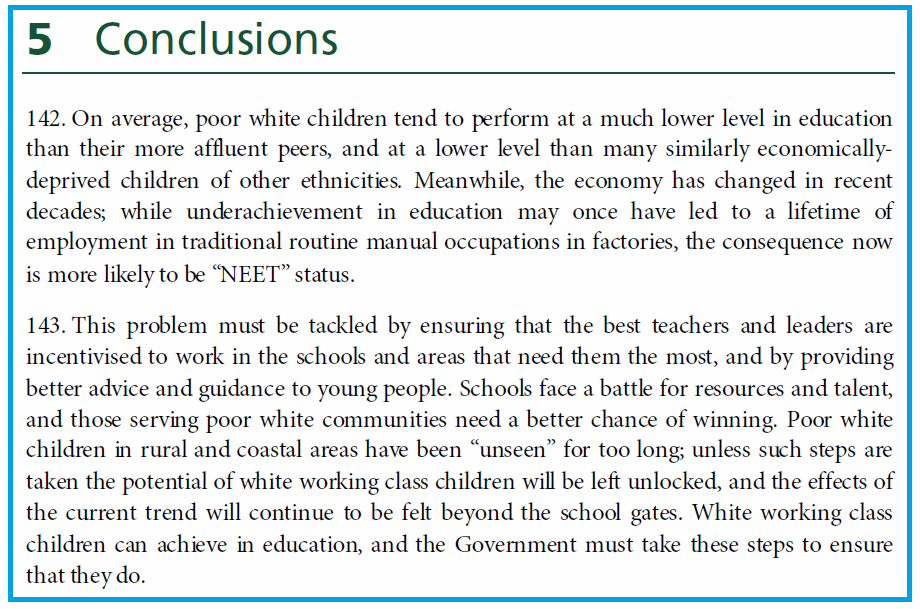You are here
- Home
- Comment and Debate
- The Underperformance of White Working-Class Students (5)
The Underperformance of White Working-Class Students (5)
In my last posting I observed in passing that those concerned about the “white working class” do not necessarily think of this category as simply “poor white”. In fact, the British working class (white or not), especially post-war, cannot simply be thought of as poor – as necessarily partaking of compensatory social benefits and resources. Few British miners, builders, factory workers, agricultural workers, crafts workers, shop-floor workers etc. – drawing a wage or self-employed, more or less skilled – could be thought of as such; it should be offensive to suggest it. Unemployed workers are a shifting proportion of the poor (the reserve army of labour); chronic unemployment (a gauge of economic crises) has a particularly deleterious effect on the working class in that sense (white or not). And only a proportion of the working class in employment (those being forced into subsistence wages) could be included among the poor. It is doubtful whether working-class ideologues ever owned to what used to be disparagingly called “vagrants” or “lumpen proletariat”, or less disparagingly “destitute” by birth or circumstances, which certainly make up some numbers of the poor. It seems odd therefore that in contemplating the school performance of a constituency which thinks of itself as white and is considered by one marker (eligibility for free school meals, partaking of a benefit) to be poor should so readily be designated as “white working-class”. In fact, in most news and government reports “poor white” and “white working class” is fluently used interchangeably, even, at times, while noting that “poor” and “working class” do not quite gel.
In fact, none of the tables and reports on underperformance in school tests that I have mentioned is really about the “white working class” in Britain, they are all about the “poor white” in Britain. The question really is: why does it seem okay to designate them as “white working-class”? What are the implications of such designating?
To this question, as I said before, the next and final posting on this theme is addressed. For this posting, let me stick with the received terms of my theme: the underperformance of white working-class students.
IF it were accepted that the evidence cited in news and government reports on underperformance by white working-class students is robust, and that those who are designated as white working class are aptly so described, and all this does have something to do with Equal Opportunities interventions and “multiculturalism” and ethnic minorities…. previous postings were devoted to questioning each of these points, but IF they are all taken at face value…
THEN there are some consequent interpretations and policies to consider. These are laid out at considerable length in the House of Commons 2014 Report, Underachievement in Education by White Working Class Children, and the Department of Education Research Report of June 2015, A compendium of evidence on ethnic minority resilience to the effects of deprivation on attainment .
The first of these gives the most detailed account of interpretations of (explanations for) such underachievement (in Section 3) and of policies and interventions that are already in place or desirable for addressing it (in Section 4). I will not try to summarize these deliberations in any detail. As is typical of government reports, they are full of hedges which leave all options open while seemingly pushing a direction: “poor” is not necessarily “working class” but it’s okay to say so; cultural difference, quality of schools, curricula, parental support, genetic factors, etc. may be playing a role but in indeterminate ways; various interventions might have worked in favour of ethnic minority students but it’s difficult to tell; everything that might have worked should be taken on board but with caution; and so on. Very briefly though: there’s a tendency to take ethnicity into account in offering explanations in Section 3 (naturally, since ethnicity-tracking is the structure whereby underperformance is understood); and the policy implementations and recourses discussed in Section 4 stick to those Equal Opportunities principles outlined in the previous posting (especially that benefits and resources would be distributed according to need and irrespective of ethnicity, to alleviate disadvantage generally rather than to target ethnically identified constituencies).
Section 3 is of interest for those who wish to explore how ethnicity is conceptualised in government and policy circles. That’s not in itself the theme of this posting. The sub-titles of Section 3 of the House of Commons 2014 report gesture towards the range of explanations considered, and it is not difficult to guess where and to what purpose ethnicity features there:

The appearance of “genetics” there might give some readers pause; unsurprisingly, this is the most circumspectly phrased insofar as ethnicity is concerned (ethnicity doesn’t appear there, the focus is on individual variation). It is however interesting in itself, both in drawing on genetics research showing that proclivity to academic study is significantly inherited and in revealing obvious bureaucratic unease about this research. The kind of research indirectly referred by the expert in question here, Robert Plomin, is best gauged by being consulted directly – e.g. this paper entitled “Why children differ in motivation to learn: Insights from over 13,000 twins from 6 countries” (2015).
In terms of the policy recommendations and implementations outlined in Section 4, there is nothing exceptional. It stays within the range of Equal Opportunities principles outlined in the previous posting. The emphasis on ethnicity in understanding white working-class underachievement might have led to two kinds of policy directions: (a) withdrawal of interventions which putatively advantage ethnic minorities now that their school performances are satisfactory (i.e. inferring that disadvantage arising from prejudice towards ethnic minorities is over); (b) introduction of interventions which could similarly and particularly advantage white working-class students so that their school performances improve (i.e. inferring that white working-class underachievement is the result of prejudice). In fact, there isn’t any of the former sort there to be withdrawn, and not much of the latter sort can be conceived that can’t be covered by benefits and resources directed towards disadvantaged constituencies generally. So nothing controversial pops up there. Quite reasonably, section 4 subscribes to the universal and, especially, needs-based principles of compensation for Equal Opportunities. Ethnicity might seem key to presenting and explaining the problem but doesn’t impinge especially upon the policy.
And yet, amidst these negotiations, there is a subtle but marked drift. There is found, throughout this report (and other such reports), a kind of performance of linguistic racialization. Amidst the vague and shifting boundaries of working class, poor, disadvantaged, and so on, whiteness comes to be focalised – all those vague terms get drawn into the designation of white, which is rendered stable. So, the working class, the poor, the disadvantaged seem now less like conditions that attach to strata of the British population in general, to some citizens at large, and seem to become a particular characteristic of an emphatically white population. It doesn’t pass into the executive statements of policies and initiatives, but it is engrained in the rationales – the very language – which surround policy making; in other words, the policies and initiatives don’t apply specifically to the white population, but are nevertheless thought about and expressed in terms of whiteness.
By way of illustration, consider these concluding paragraphs of the House of Commons 2014 Report :

[NEET stands for “not in employment, education or training”] There are, in these two paragraphs, “poor white children” (twice), “poor white communities”, and “white working class children” (twice) as against – and in contradistinction from – “similarly economically-deprived children of other ethnicities”. It is perhaps not wholly insignificant that children of other ethnicities are almost never characterised as “working class” or “poor”; the adjectives there are more technical-sounding and less redolent of affective appeal – “similarly economically deprived”, and elsewhere “the same socio-economic category”, neutrally “disadvantaged”, and so on. These latter terms suggest a kind of conditional equivalence without enabling inclusive characterization as “poor” or “working class”. “Poor” or “working class” only seem meaningful as terms if appended to “white” here – and throughout the report. That’s a linguistic performance. It is not easily pinned to policy, but it shapes a habit of thinking around and about policy – which could be distilled from there into media discourse, academic discourse, advocacy and mobilization at ground level, popular culture, everyday talk.
And that is interesting. That linguistic performance itself serves the purpose it announces, of not letting poor white children be “unseen”. Seeing is colour-coded.
Suman Gupta
May 2016
